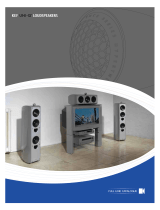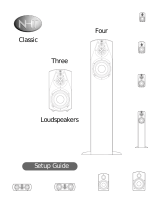Monitor Audio 893SFX7BG Owner's manual
- Category
- Speaker sets
- Type
- Owner's manual
This manual is also suitable for
Monitor Audio 893SFX7BG is an in-ceiling speaker that delivers exceptional audio performance for home theater and music listening experiences. Its three-way design features a pivoting mid-range/tweeter module for precise directivity, while the 8-inch bass driver ensures deep and impactful bass. With a power handling capacity of 100 watts RMS and a frequency response of 45Hz-25kHz, the 893SFX7BG reproduces audio with clarity, detail, and dynamics. It's ideal for use in Atmos setups, where it can create an immersive and realistic soundscape.
Monitor Audio 893SFX7BG is an in-ceiling speaker that delivers exceptional audio performance for home theater and music listening experiences. Its three-way design features a pivoting mid-range/tweeter module for precise directivity, while the 8-inch bass driver ensures deep and impactful bass. With a power handling capacity of 100 watts RMS and a frequency response of 45Hz-25kHz, the 893SFX7BG reproduces audio with clarity, detail, and dynamics. It's ideal for use in Atmos setups, where it can create an immersive and realistic soundscape.













-
 1
1
-
 2
2
-
 3
3
-
 4
4
-
 5
5
-
 6
6
-
 7
7
-
 8
8
-
 9
9
-
 10
10
-
 11
11
-
 12
12
-
 13
13
Monitor Audio 893SFX7BG Owner's manual
- Category
- Speaker sets
- Type
- Owner's manual
- This manual is also suitable for
Monitor Audio 893SFX7BG is an in-ceiling speaker that delivers exceptional audio performance for home theater and music listening experiences. Its three-way design features a pivoting mid-range/tweeter module for precise directivity, while the 8-inch bass driver ensures deep and impactful bass. With a power handling capacity of 100 watts RMS and a frequency response of 45Hz-25kHz, the 893SFX7BG reproduces audio with clarity, detail, and dynamics. It's ideal for use in Atmos setups, where it can create an immersive and realistic soundscape.
Ask a question and I''ll find the answer in the document
Finding information in a document is now easier with AI
Related papers
-
Monitor Audio HYPHN Owner's manual
-
Monitor Audio Silver 100 Owner's manual
-
Monitor Audio Platinum Series Floorstanding Speakers User manual
-
Monitor Audio P3G200W User manual
-
Monitor Audio Platinum In-Wall User manual
-
Monitor Audio MASS Surround Sound Speaker System Owner's manual
-
Monitor Audio Silver 2 Specification
-
Monitor Audio Silver 63 User manual
-
Monitor Audio 100 Series Owner's manual
-
Monitor Audio Gold GX300 User manual
Other documents
-
Polk R500 Floor Standing Loudspeakers Owner's manual
-
Definitive Technology DM70 Bipolar Floor Standing Speaker User guide
-
Emotiva X-Ref User manual
-
KEF PSW5000 User manual
-
Mission M31ICR User manual
-
Revel F206 Owner's manual
-
 KEF Audio Portable Speaker Loudspeaker User manual
KEF Audio Portable Speaker Loudspeaker User manual
-
Tannoy PRESTIGE TurnberrySE Owner's manual
-
 NHT Three Owner's Manuals
NHT Three Owner's Manuals
-
Mission E34 ZWART Datasheet














